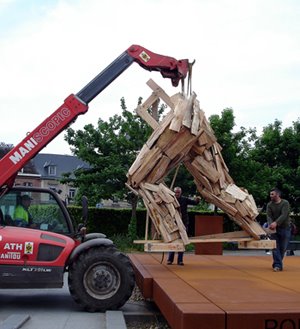 Red Shift I: Impregnation (detail) 1967-1984, Collection Inhotim Centro de Arte Contemporânea, Minas Gerais, Brazil © Cildo Meireles
Red Shift I: Impregnation (detail) 1967-1984, Collection Inhotim Centro de Arte Contemporânea, Minas Gerais, Brazil © Cildo Meireles
 Fontes (detail) 1992/2008, © Courtesy the artist, Photo: Tate Photography
Fontes (detail) 1992/2008, © Courtesy the artist, Photo: Tate Photography"My work aspires to a condition of density, great simplicity, directness,
openness of language and interaction." Cildo Meireles.
Présenté comme l'artiste conceptuel contemporain le plus important du Brésil, voici présentée à la Tate Modern une exposition passionnante qui réunit une série de "fortes" installations de celui-ci dans une suite de 7 pièces."For me the art object must be, despite everything else, instantly seductive."
Cildo Meireles."I like dealing with paradigmatic things, material things that are recognised by the public in their everyday lives, things that are at the same time matter and symbol. Money for example." Cildo Meireles.

 Missão/Missões (How to Build Cathedrals) (detail) 1987, Daros-Latinamerica Collection, Zurich © Cildo MeirelesPhoto: Tate Photography
Missão/Missões (How to Build Cathedrals) (detail) 1987, Daros-Latinamerica Collection, Zurich © Cildo MeirelesPhoto: Tate Photography...["The finest piece from the post-1984 period is Mission/Missions (How to Build Cathedrals) (1987), which was shown at the ICA in London in 1990. This is the most visually spectacular of all his installations, and the most explicitly religious. It was made for an exhibition exploring the Jesuit missions to South America between 1610 and 1767, when the Jesuits were themselves suppressed by the papacy. Around 600,000 coins are laid out like a square carpet on the gallery floor, and from the mid-point, a thin column of communion wafers rises around eight feet into the air where it meets a matching suspended square canopy made from 2,000 bones. Meireles has explained: "I wanted to construct something that would be a kind of mathematical equation, very simple and direct, connecting three elements: material power, spiritual power, and a kind of unavoidable, historically repeated consequence of this conjunction, which was tragedy. I wanted a sky of bones, a floor of money, and a column of communion wafers to unite these two elements." Here, as so often in Meireles's work, mathematics is moralised and given a troublingly tangible architecture".]...James Hall , The Gardian
La page de l'expo sur le site de la Tate Modern : http://www.tate.org.uk/modern/exhibitions/cildomeireles/explore.shtm








